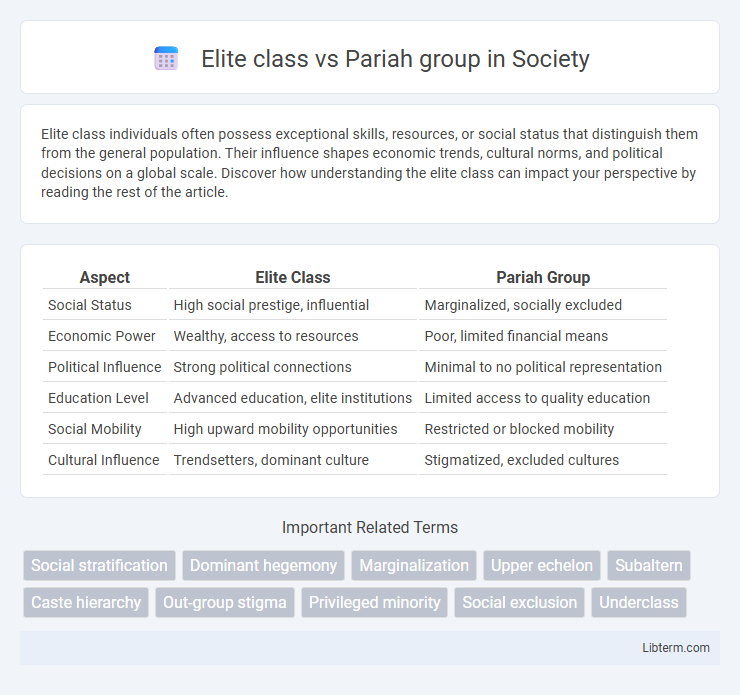Elite class individuals often possess exceptional skills, resources, or social status that distinguish them from the general population. Their influence shapes economic trends, cultural norms, and political decisions on a global scale. Discover how understanding the elite class can impact your perspective by reading the rest of the article.
Table of Comparison
| Aspect | Elite Class | Pariah Group |
|---|---|---|
| Social Status | High social prestige, influential | Marginalized, socially excluded |
| Economic Power | Wealthy, access to resources | Poor, limited financial means |
| Political Influence | Strong political connections | Minimal to no political representation |
| Education Level | Advanced education, elite institutions | Limited access to quality education |
| Social Mobility | High upward mobility opportunities | Restricted or blocked mobility |
| Cultural Influence | Trendsetters, dominant culture | Stigmatized, excluded cultures |
Defining the Elite Class and Pariah Group
The Elite Class consists of individuals or groups who hold significant power, wealth, and social status, often influencing political and economic systems. In contrast, the Pariah Group is marginalized, stigmatized, and excluded from mainstream society due to social, cultural, or moral disapproval. This dichotomy highlights the structural inequalities and social hierarchies that shape access to resources and opportunities.
Historical Origins of Social Stratification
The historical origins of social stratification trace back to early agrarian societies where Elite classes emerged as landowners and rulers controlling surplus resources, while Pariah groups consisted of marginalized communities often assigned menial or stigmatized roles. This division solidified through religious doctrines, legal systems, and economic dependencies that institutionalized inequalities, embedding status distinctions across generations. Archaeological and anthropological evidence from civilizations such as Mesopotamia and ancient India highlights how these hierarchical structures shaped societal organization and individual identity.
Power Dynamics: Control vs. Marginalization
Elite classes maintain power through control of economic resources, political influence, and cultural institutions, reinforcing hierarchical structures that sustain their dominance. Pariah groups experience systemic marginalization, facing exclusion from mainstream opportunities and decision-making processes that limits their social mobility. This power dynamic creates persistent inequalities, where elite control consolidates privilege while pariah groups navigate barriers to inclusion and recognition.
Economic Disparities Between Groups
The Elite class controls a disproportionate share of global wealth, owning over 80% of financial assets, while the Pariah group experiences chronic poverty and limited access to basic services. Economic disparities manifest in unequal wages, restricted educational opportunities, and minimal social mobility for the Pariah population, perpetuating systemic inequality. Wealth concentration in the Elite class fuels political influence and economic policies that often exclude marginalized communities, exacerbating social fragmentation.
Social Mobility and Barriers
Elite class members maintain social mobility through access to exclusive education, wealth, and influential networks that reinforce their status and limit upward mobility for others. Pariah groups face systemic barriers such as discrimination, lack of political power, and economic exclusion that significantly restrict their social advancement. Structural inequalities in employment, housing, and social policies perpetuate the divide between elite classes and marginalized groups, creating persistent obstacles to equal opportunity.
Cultural Perceptions and Stereotypes
Elite class members are often perceived as sophisticated, educated, and powerful, associated with wealth, influence, and access to exclusive opportunities. In contrast, the pariah group faces cultural stereotypes of marginalization, deviance, and social exclusion, often linked to poverty, criminality, or countercultural behaviors. These perceptions deeply influence societal interactions, policy decisions, and the reinforcement of social hierarchies based on cultural narratives and identity constructs.
Role of Politics in Group Relations
The Elite class wields significant political power, shaping policies and access to resources that reinforce their dominance in social hierarchies. In contrast, the Pariah group is systematically marginalized, often excluded from political participation and subjected to institutional discrimination. Political structures serve as mechanisms that both legitimize elite influence and perpetuate the subordination of pariah groups in societal relations.
Impact on Education and Opportunity
Elite class members often benefit from exclusive access to high-quality educational institutions and extensive networking opportunities, reinforcing their social and economic advantages. Pariah groups face systemic barriers such as underfunded schools and limited career prospects, which perpetuate cycles of poverty and social exclusion. These disparities in education and opportunity exacerbate social stratification and hinder upward mobility for marginalized populations.
Resistance, Uprisings, and Social Change
Elite classes often use economic power and political influence to suppress uprisings and maintain social hierarchies, employing sophisticated surveillance and law enforcement strategies to resist resistance movements. Pariah groups, marginalized by systemic inequalities and social exclusion, drive social change through grassroots resistance, mobilizing protests, strikes, and civil disobedience to challenge oppressive structures. Historical patterns reveal that sustained uprisings by disenfranchised groups can gradually erode elite dominance, reshaping social norms and policies toward greater equity.
Pathways Toward Social Integration
Elite class members often gain social integration through exclusive education, professional networks, and cultural capital that reinforce their status. Pariah groups face significant barriers due to stigmatization, limited access to institutional resources, and social exclusion, which hinder their pathways toward integration. Strategies for overcoming these obstacles include community empowerment, targeted social policies, and inclusive dialogue to bridge social divides.
Elite class Infographic

 libterm.com
libterm.com